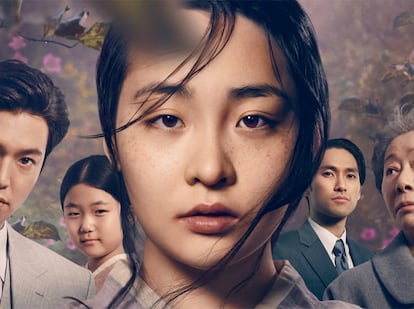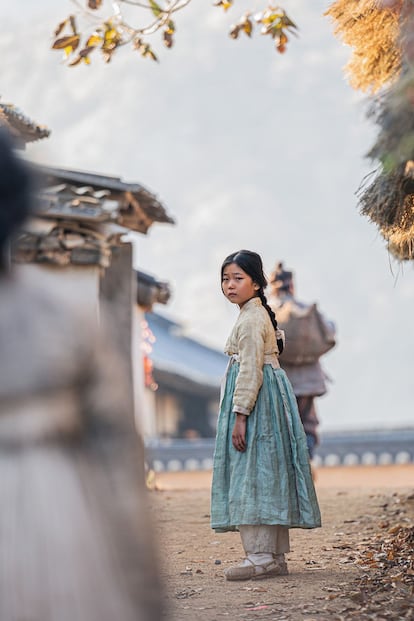The sex slaves who served the Japanese Imperial Army and other unexpected tributes in ‘Pachinko’
Apple TV’s work of fiction puts the focus on various generations of women who history left out. It hooks viewers and proves the British don’t have a monopoly on historical dramas

The series Pachinko, which premiered a few weeks ago on Apple TV, has told me more about the painful interior lives of Korean women during the Japanese occupation of 1910 than all the documentaries I’ve watched on the topic. Well, in a manner of speaking, but it’s well-deserved. The series, majestic and based on the equally superb book, has some very gifted female characters (Sunja as a girl, a woman, and an elderly person come to mind) who are full of stories both tiny and enormous that are tender, potent, and seldom seen in audiovisual media.
Pachinko is a historical drama that narrates 80 years in the life of Sunja, the main character, as well as that of four generations of this Korean family, which saw how the peace was broken in 1910 after Japan’s invasion. The show’s creator, Soo Hugh (The Terror), tells the story of the journey Sunja’s family makes over the course of almost a century, from 1910 to 1989, and pays tribute to the women who history has hidden or left out so many times. Hugh tells of the horror, the love, the solitude, the grief, the integrity of her female protagonist in a new way, which is the axis of everything, and she also depicts Sunja’s family and personal environment.
Everything is poetry in Pachinko, for which four seasons are planned. This first season, with its eight episodes, is beautiful, tough, convincing and above all tranquil, worthy of being consumed little by little, to verify that each gesture made by the characters encloses a whole world of contradictions, silences and fears. We had seen other audiovisual works produced in South Korea about the invasion –which lasted 35 years, until 1945– and its horrors, but few that focused on the women who endured, who immigrated and who as always suffered twice as much.
For example, there’s the story, left out of cinema as far as I can remember, of the so-called “comfort women,” the sex slaves from South Korea who served the Japanese Imperial Army during the occupation of South Korea and China. Despite the fact that this issue and its remembrance greatly complicated the relationships of Japan with various of its Asian neighbors, no one producing fiction had focused on them as protagonists beyond the status of mere decorative elements in war stories of action, spies and so on. Many of these women died in military brothels without ever receiving an apology from the Japanese authorities. In 2017, South Korea revealed the first known recording of these women.

Pachinko is special as well for that reason, for putting the focus on something that no one had focused on before. It’s based on the powerful novel of the same name, which was published in 2017 by Min Jin Lee, who is of Korean descent but has lived in the US since age seven. The book immediately became a bestseller; it leaves you stuck on the sofa out of pure empathy and the desire to know more, to get to know the hidden facets, to understand why there was so much unhappiness. The senselessness of war, of the occupation, of the invasion, captivated many readers, among them former US president Barack Obama, who read the book on the recommendation of a team member: “It’s a powerful story about resilience and compassion.”
And just like the novel (whose more than 500 pages I devoured two summers ago, helpless under the bougainvillea) the Apple TV series, which last Friday premiered the second-to-last episode of its first season, is abundantly lyrical. Never had such beautiful landscapes seemed so desolate. There we see the Japan-occupied Korea of the beginning of the 20th century, the Japan of the years before World War II, and the Japan of the end of the 1980s. And in these immense landscapes, in these scenes that accompany the protagonists in adversity, love, tenacity before horror, we find everything: identity, nation, belonging, uprooting and pain, and above all resistance. The phrase which begins both stories, the written version and the on-screen version, says it all: “History has failed us, but no matter.”
I return to what The New York Times said about the novel, which has been translated into 30 languages: “Lee suggests that behind the facades of wildly different people lie countless private desires, hopes and miseries, if we have the patience and compassion to look and listen.” We can say exactly the same of this Korean-Japanese epic, which is unusually intimate and so fun to watch.
Lee, the author of the novel and a columnist in different South Korean media, was designated in 2018 as one of “10 Writers and Editors Who Are Changing the National Conversation” and she dedicated a good part of her life as a writer to composing this novel which she called Pachinko with a clear intention in mind: it’s the name of a traditional and very popular Korean and Japanese game, something like pinball. It’s a game where chance is important and where the player barely has a say. The same thing happens in the lives of the female protagonists.

They, the women of this story, represent so many other strong, hardworking women who have been hidden and cast aside. They deserved this series, which at last shows them as protagonists. They deserved this audiovisual story that recreates details to explain the beautiful relationship between parents and children, the strong links that connect Sunja with her mother and with the other women with whom she spends time, broken innocence, and the unbearable pain of absence. There are boundless emotions (the goodbye scene between mother and daughter, when the latter, recently married, leaves home on a boat for Japan will break your heart) and contained emotions, perturbing and evocative images, and some formidable visual analogies between the different time periods that the series covers.
The creator of the series, like the author of the book, has been stubborn about paying tribute to the women who didn’t give up when they had everything going against them, and also paying tribute to those who had no option but to give up: those who stayed in occupied Korea, suffering the invasion in their lives, and those who left and never returned. It’s a series filmed in South Korea, Japan and Canada in Japanese, Korean and English, without making an issue of it, with an immense cast of protagonists and secondary characters that represent the four generations of the same family and that tell nothing more and nothing less than the history of Asia in the 20th century.
Then there’s the title sequence, which is a sigh of relief in light and color for the story that awaits us, which breaks with the sad and gray clothing that Pachinko will give us. It’s a musical and visual fantasy set to the sound of that great American group from the close of the 60s, the Grass Roots. The song that gets the protagonists dancing, Let’s Live for Today, which has 15 million streams on Spotify, is reminiscent of the Byrds, the Zombies, the Monkees, the Beach Boys, of that pop rock which came after the Beatles. With this music, the veteran actress Youn Yuh-jung shows her fun side. She plays Sunja as an elderly person and won an Oscar in 2021 for Minari. And that title sequence makes it so you enter into the series with the wind at your back.
Once there, there’s no shortage of hard scenes, but also no excesses; there isn’t gratuitous violence, everything is suggested, nothing is hyperbolic. A few looks from the protagonist are sufficient to understand the unmeasured nature of that colonization, the submission that Korean citizens suffered. There’s a scene, set in 1989, in which Solomon, Sunja’s grandson in New York, is told by his American boss, after an uncomfortable moment of tension: “Oh, right, that whole situation of the Koreans against the Japanese. Why don’t people get over that already?” The lack of empathy is made clear, and at that stage in the series you can’t help but to feel it.
Women and rice
Immigration and its difficulties, racial discrimination, generational divides…the weight of tradition, of others’ opinions, the bonds between women who literally saved one another’s lives, or at least lightened their anguish, their vital fear. That’s why there are the culinary scenes, rice, spices, barley, garlic, white radishes, fish, cuts of meat, the market, the bustle of the kitchen. Through a bowl of white rice (having or not having it), Lee knows how to tell us a part of the family history. A fish, a soup, a rice cooker of black clay cooking the rice, show a whole universe.
There’s a moment in which Sunja, recently arrived to Japan at age 16, installed in the house of her kind sister-in-law (who will be a key figure for the rest of her life), sits at the table and discovers a bowl of white rice that sends her back to her childhood to her mother. She cries and so will the viewer.
I found out from the series that white rice had been banned for Koreans during the occupation. It was reserved, due to scarcity, just for the Japanese colonizers. Sunja’s mother wants to offer her daughter rice and not millet or sorghum, the substitutes that are allowed for Koreans, for the last dinner before her journey. She goes to the market and begs the vendor to sell her two bowls, knowing that it’s prohibited. The vendor won’t do it, saying “If they find out, I will pay the price.” But she tells him that she doesn’t have a dowry to give her daughter, that she doesn’t have anything, that she can only offer this bowl of rice, prepared with love for her, so that she leaves with its taste in her mouth. The vendor takes pity on the woman and sells her the rice in secret. It’s a powerful scene, of total love, that will move you.
When she arrives home she washes the rice, prepares it with sweetness, with care, and serves it to her daughter, who cries when she uncovers it. She knows well what that bowl represents. She’s leaving behind the women of her house and those harmonious relationships, her trips to the river to take care of the laundry, her visits to the market, and the total love of her mother. She will not return to her country, and she knows it. And leaving with her are thousands of other Korean women who will likewise never return to the country of their childhood. The only thing she can take with her is essentially the taste of her mother’s white rice.
Is Korean fiction here to stay?
For the director of production consulting and content for Geca, Gloria Salo, this series reflects Apple TV’s initiative “to produce local products in those areas of the world which stand out for their interest on a creative or business level.” In fact, Apple TV won the rights to the book after a hard battle with other businesses that were also interested in it (the book was selected as one of the 10 best of 2017 by The New York Times). The series has put the platform in a privileged position in the world of large audiovisual productions. “There’s a trend of literary adaptations that’s popular worldwide. There’s an effort to tell stories that the public already knows because their book versions were so successful.”
According to Salo, “the family element is present in various Korean productions, especially in the so-called ‘chaebol dramas’ centered on powerful families who own large business consortiums and conglomerates, like Main on Netflix. Family relationships appear in productions like Sarangui Kkwabaegi or Hyeonjaeneun Areumdawo, both on KBS2, an important South Korean television channel.”
After the success of Parasite, which won the Oscar for Best Picture two years ago, Netflix premiered Squid Game in 2021. It revolutionized the audiovisual world for a while and told us that South Korea, and its efforts in the world of fiction, are for real. Also on Netflix, the romantic comedy Business Proposal tops the most-watched list.
Tu suscripción se está usando en otro dispositivo
¿Quieres añadir otro usuario a tu suscripción?
Si continúas leyendo en este dispositivo, no se podrá leer en el otro.
FlechaTu suscripción se está usando en otro dispositivo y solo puedes acceder a EL PAÍS desde un dispositivo a la vez.
Si quieres compartir tu cuenta, cambia tu suscripción a la modalidad Premium, así podrás añadir otro usuario. Cada uno accederá con su propia cuenta de email, lo que os permitirá personalizar vuestra experiencia en EL PAÍS.
¿Tienes una suscripción de empresa? Accede aquí para contratar más cuentas.
En el caso de no saber quién está usando tu cuenta, te recomendamos cambiar tu contraseña aquí.
Si decides continuar compartiendo tu cuenta, este mensaje se mostrará en tu dispositivo y en el de la otra persona que está usando tu cuenta de forma indefinida, afectando a tu experiencia de lectura. Puedes consultar aquí los términos y condiciones de la suscripción digital.
More information
Últimas noticias
Welcome to the post-religion era: The idea of Christianity as the absolute truth has become obsolete
‘I thought you would like it’: The risky sexual practice popularized by TV shows and TikTok
The digitalization of tourism: ‘They promise experiences and gave us the worst possible one’
Mexican peso defies uncertainty with forecasts of a new period of stability in 2026
Most viewed
- Sinaloa Cartel war is taking its toll on Los Chapitos
- Reinhard Genzel, Nobel laureate in physics: ‘One-minute videos will never give you the truth’
- Oona Chaplin: ‘I told James Cameron that I was living in a treehouse and starting a permaculture project with a friend’
- Why the price of coffee has skyrocketed: from Brazilian plantations to specialty coffee houses
- Silver prices are going crazy: This is what’s fueling the rally










































